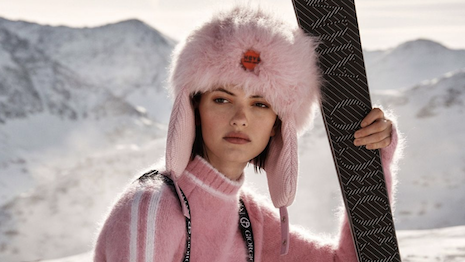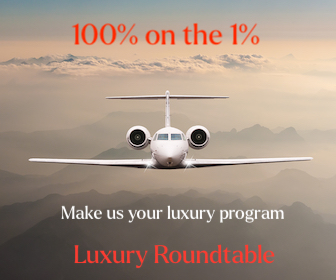The global luxury fashion market size was valued at $280.92 billion in 2022 and is expected to reach $401.73 billion by 2028, growing at a compounded annual growth rate of 6.14 percent.
Online sales of luxury fashion is anticipated to experience substantial growth during the forecast period, per a new report from Arizton.
Fit for growth
The surging popularity of athleisure wear is propelling the luxury fashion market.
The rising popularity of athleisure has surged the demand in the market due to serval factors, such as attracting the younger generation, health-conscious and changing consumer preferences, among others.
Furthermore, the rapidly evolving technological landscape and the fashion industry's expanding embrace of technologies such as augmented reality (AR), coupled with the growing proliferation of digital channels in emerging markets, are creating fresh growth prospects for luxury fashion market vendors, according to the report.
In North America, the increase in the number of millionaires is expected to support the growth of the luxury fashion market.
Moreover, the region offers a range of high-end shopping experiences such as luxury shopping districts, flagship stores and exclusive boutiques.
Tourists, especially those from countries with limited access to luxury shopping, may be drawn to these unique experiences. They are more likely to make luxury purchases during their trips and support the market growth.
The U.S. holds a significant share of the luxury fashion market in North America.
The country has the largest number of billionaires worldwide. The U.S. enjoys a high standard of living, thereby creating significant demand for luxury fashion products across the country.
Also, the growing income is likely to add to the revenue of luxury brand vendors in the market, who are driving the demand for luxury fashion products in the market, per Arizton.
Market trends and opportunities
Leveraging augmented reality
Augmented reality (AR) helps an individual experience the virtual elements in the real physical world.
Virtual reality and the metaverse are emerging technologies that have gained significant attention in recent years. It is one of the latest trends in technology and is increasingly gaining momentum in various industries.
The rising smartphone penetration and faster download speed with the launch of the 5G network are allowing various businesses to leverage AR technology and provide better shopping experiences to customers, per the report.
Various businesses in the luxury fashion market use AR to influence customers' purchasing behavior and help them make more informed decisions.
The purchase of fashion goods depends heavily on the trial of the product. Hence, customers prefer to try the products before making final purchases.
Growing inclination towards sustainable products
Customers are increasingly becoming environmentally conscious and are seeking more sustainable lifestyle choices.
There is also growing pressure from the public and the industry on luxury brand owners to decrease the environment while maintaining the luxury quotient. This has prompted several luxury fashion brands to adopt sustainable and eco-friendly raw materials for manufacturing luxury apparel, footwear and other fashion goods.
Further, luxury fashion retailers are also taking initiatives to make sustainability more visible in the luxury fashion market.
Online retailers such as Net-A-Porter, Selfridges, Matches Fashion and others have brought forward sustainability on their respective websites to highlight its importance and the growing demand for the same in the market, according to Arizton.
Growing number of high-net-worth individuals
Luxury fashion goods are priced higher due to their premium quality, durability and unique brand values. Thus, lower-income-group consumers are less likely to buy these products.
Most of the luxury fashion goods are purchased by people with high net worth.
Developing countries are witnessing significant growth in the number of HNWI, which is leading to the increasing demand for luxury fashion products in the market.
Availability of secondhand luxury products
Luxury fashion goods are highly expensive, and consumers are unwilling to give up on the products even if they no longer use them.
As a result, the reselling of such products is gaining momentum, thereby leading to the increase in growth of the second-hand market for luxury fashion goods.
Resale and re-commerce – selling of used or already owned products through online or offline channels – are the words that are increasingly becoming popular in the luxury fashion market, per the Arizton report.
Secondhand luxury fashion goods, which are the used stock of luxury goods, are increasingly gaining momentum due to their availability at lower prices.
The growth in the sale of used stock of luxury fashion goods is significantly hampering the sales of fresh stock of luxury fashion brands. Therefore, such factors are posing challenges to the fresh sales of the luxury fashion vendors in the market, according to the report.
Segmentation insights
By products
The global luxury fashion market by product type can be segmented as apparel, leather goods, watches, footwear, jewelry and others.
In 2022, the apparel segment dominated the luxury fashion market, holding a share of more than 30 percent.
There is a high demand for luxury apparel such as T-shirts, tops and shirts and shorts.
Also, the rising awareness among the population concerning various luxury apparel brands available in the market is leading to individuals' increasing acceptance of the product.
However, the leather goods and watches segment is expected to witness a high growth rate, per the report.
The lower cost of accessories as compared to apparel and footwear is expected to drive its market during the forecast period.
By end-users
Women end-users segment accounted for the highest share of the global luxury fashion market in 2022.
The growth is attributable to the increasing women's labor force and rising number of independent women.
Moreover, the inclination of women towards stylish and fashionable products has always been higher, which is contributing to the higher growth of the women segment in the global market.
Furthermore, the demand for women's luxury fashion products is expected to be high in countries with higher female participation in the labor force and high employment rates due to their higher income levels, the report said.
By generation
The global luxury fashion market by generation can be segmented as Gen X, millennials and Gen Z, as well as baby boomers and the silent generation.
In 2022, Gen X accounted for the highest market share due to their higher income and higher spending power, per the report. This generation is highly exposed to and aware of both the traditional and digital distribution channels. As a result, this generation prefers to shop for luxury fashion products both online and offline.
By distribution channel
The retail distribution channel in luxury fashion is a finely tuned system that ensures that exclusive and high-end products reach discerning consumers most efficiently and luxuriously.
At its core, luxury fashion distribution relies on a selective and strategic network of upscale boutiques, flagship stores and department stores in prime locations worldwide.
However, in 2022, the wholesale channel dominated the global luxury fashion market and is expected to grow at the highest CAGR during the forecast period, Arizton said in the report.
The wholesale distribution channel plays a critical role in connecting luxury brands with discerning retailers and affluent consumers worldwide.
Renowned luxury brands meticulously curate and showcase their collections in opulent showrooms strategically located in fashion capitals. Here, eager buyers from high-end retail stores and prestigious boutiques converge to preview the latest designs and place wholesale orders for the upcoming season.
By sales channel
The online sales channel held the most significant global luxury fashion market share in 2022 and is expected to grow at the highest CAGR of more than 7 percent during the forecast period.
The growth of ecommerce and rising awareness of the benefits of online purchases, such as heavy discounts, occasional offers, availability of several coupon codes and rising demand for convenience, are driving the growth of the online segment.
Furthermore, mono-brand stores are also a prominent part of the sales channel. The key factor contributing to the high demand for luxury fashion products from these stores is the personalized experience that customers enjoy while shopping for the products.
These mono-brand stores help luxury brands to understand the requirements and buying behavior of the customers personally.
Geographical analysis
Asia Pacific accounted for the highest share of the global luxury fashion market and claimed more than 31 percent in terms of revenue in 2022.
Factors such as increasing investments in the region, rapidly growing disposable income, and increasing awareness about luxury brands are driving the demand for luxury fashion products across the region, Arizton said in its report.
Countries such as China and Japan emerged as the leaders across the region, accounting for most of the share.
APAC was led by China, Japan, India and South Korea, which are significant markets for raw materials.
Moreover, the continuous rising disposable income of the middle-class population is supporting the luxury fashion market across the region.
Likewise, the increased access to international luxury brands is likely to push product consumption.
Therefore, several brands are expanding their footprint in the APAC market to serve the large customer base.
Competitive landscape
The global luxury fashion market has a significant number of large players and several small players.
LVMH, Kering, Burberry, Armani Group and Prada Group are among the key players in the market.
Other players operating in the global luxury fashion market include Swatch Group, Moncler and MCM.
Rising competition is pressuring various vendors to continuously innovate their offerings with a unique value proposition to survive in the industry.
These marketers are required to invest a significant sum of money in research and development to introduce new technologies, enhance their offering and expand their product portfolio.
Although established players dominate the industry, there are tremendous growth opportunities for new entrants who are strategizing to tap the market by entering niche segments.
Recent developments in the luxury fashion market:
- Armani: The organization expanded its business and focused on opening new green outlets due to consumers being able to access a wide variety of products. For instance, in 2021, the company opened seven new green retail outlets in Italy.
- LVMH: Louis Vuitton owner LVMH group is focused on expanding its production capacities to ensure sustainable growth. With this, the company is expected to expand its product portfolio and brand value in the luxury fashion market.
- Burberry: The British company’s strategy is to maximize the potential of all product categories, ensure that they thrive and achieve optimal performance. It will rely on innovative approaches and resources to drive growth and success.
{"ct":"gdGMaOpNyvzauWHph05tnlwwoavhCW4Cp0iUmWnAXnqIOV8MW+HaiP5W\/Y0eXxURUmd+fEaGEQkcc+PHt3ixICaOrJuXvC1\/NgRieQ7xCnqU0PjuK9ZhVpbJC0QGv7MA9nppgNMShmFcglCseuWcY1eWZ2T8mQs8pqkb3usWtFtIVlFxJuLqzG6868laHXro4LaKJ1NYM2FCPDKP0I\/Y3cAnpwOQuzc\/eykw5WLaI4KGWTuhs+H5Z9OVDqRRovr5XfjYmCUJXkOBfxBZm28Bq+Ek7Q9rOeIyP5b7j94mmoZOSWXqETeT9xZvOIr21U+C7MP2aUqJxC\/3AZm9z9UPz6BfnfAzSyNwhQn3jo6jq018RPzb7+LtKDR7EalrgzkOoflP+24qWZBN7TbEOFuiEyvp69xS7Mrf74fUboqoPwdJjLNnT7xHcM1UMZJ4JAQ9y0a08CeZcTU7D1MDiUFy49lC7TxIFgGDg+rkckPcmCGW539J7QkJUqDo9qRKGPkYha0mbDCnJAcdQ2r1uRybmoFjugqRKTyITRBBTd5Fzd1wDljoY4ZJ6CeOpxosUdlx\/k40nfV+RGh2uJSIRl1TDeuwBQYrsniCnWoXYV9wFNnmKYQtdv7ASQOPj4WhM963YRcuhyuzDH4VvbSa7GttjCFM9pGfjwi1K23C6IFDMln3\/iLGdJLYLucwp7RD\/WB1CFPpAAn3BxjQ5jVzTJhMyoWv+bnaylhNXuWkv7Z5rQa1nXIw4JrSW8\/rdNT\/HaYvgWzTbPdqNJBr+Q+8fP3mR8pfF2kMtR2YeTUkDilFb1p1ZgR81QGAJZogOvgzDa+PTrd0nkX4lGQP0JHSf9vQGdkJ8hwNJX28oImzAR2Oz6gK8obRoLSLoqCyFo1mqT+f7zgWWU+XlrZ3wPNgn8Rbc++nhfz8BBFqSsdoCw6EmyYmnj9UQUJ7E38yW8C6l2PXP8kYGaRnPprPY3IOGVLnArPacqqmaeY9jMEWq9To+\/zdRs\/o0GdGb3tIDnRdT30UIpMJoY4tSLm7iGW1CVpmWUO\/FzyUpfqUo9AzbmUKOvB+REosnIGULhC6qW2GP0XjX4H+McsxWaYzUHpRP3VWdaYQWJhGgTQcE8j2i\/1\/1OPSLFSoxaqdvv6DjURIS5K2TUuh1J5kGjAvDmu2zUekMQ2wxYHMX5hpv+KNyYQAeyQdBg5Ur2eebndTOu\/ZAjjE5vsZtbJHg\/pUKbFW13nupOtJ1CxQcGhJoHycFKPVPW+5gQ\/fJ2VS9S01VLAxtYwiB6z9H2hca2KKO8J7TDKZacaOMFE48wf\/GDNE88ZFm83KzeqKK0\/69iMxBvVPCi\/sh63hjji4NCuGbpykuiZQlTS9A0NaSk6d4D0mwwokM3twjUhH97Hx9w19OU0TkNtTzj7Czt1ImyplP37h35CSDGe6SJvz+z0Q4ZgJo+nnopOztpxIhCyTqFMMfmmHYVThSaFlbRVYFjNPK\/hmd86MwLhptyVpveFiUSmMi8LdZ2saQxHU0QeSWCNGPngkKcJUjWfY6htqkgJhzcGqM73l11f7H\/Wqe64AvmFYucM5W1BomuX3vB+NsrZP8w3beWw3GAWVWmwwL0bq7hLlIai3IZGc0lfQ+xjoqfxzvx03ozj2yfcRIBuG92qvuDgxEQwsdqIoEoLtdo1tU682i989gd2EW73JzcGF2ofzF3ibDmzsXv+S\/ZiBOBe0G6TU72NeK8\/xsH7AkKhhTeOD+QnbuTf3+PqBrpqEPhu42cC9AI+Yn+qhUflfKqthkwToow65dwUfF+Q1UZyRZEyaasRmaZ+S+aRe1sRxw3hkD\/wB2pBq1SouVyRo+ZTAK7x1IB2+5Dd9nkwAQNUu\/M\/8Jru6N23XJdaXqOs+uudQux7Wll9C6TjXmgyIUH+prfCN\/BSyMtE2HJu6JnDuh4yCWgYaO9PULk0MWSFxWl2OYzaVPMMdSCG1fRr7Pd1RfzbK4OP+JnMtn+0h9wRBVJZ8EkpucLlITUKaNqJ0Wk03cNNNLf3WulQQWf4zxx5KDUYNYjj8DregmBozUkOK3ZDyV6qHccB0JyHSSdeHFIjQJCXY06yUrqBd3tle05uYizeyO+52tl8grGNN6Gb5bMbCjR+gaUKTzKJwa7hGt1ld005B87ygfLMThpPazEvI8Bj7SZitCmYyyqcsHMHQBQozLxn4+mWQbT4JW0Kk+zYGyz\/zK5eDZjlhhETvpoGj9o4fdlNeeYXJqpeuyGMQwUynTT73gq7xdmtNtnirr3uZ9oHzeGr0C\/2PME8TxkYRFGdESn+F6LCHNX\/pCg9fbz1ppe7TOlqlUSEmE5O05eCdADnfpW+4raa6hDiDwmsTTJvgfUXlC\/hhtynt9BlVQ9dSbPBfBx69d9hLFrCQx5wvQqfr5H9yLXpXBOs0l51nRKqZ4Y5QmdepP169ck2R4r5SI728jPaLkCwG5iNLMsEKNMsoLy\/QI7Gp1wL8L9ogsRkzn8jzHugUMMWNQtDoksGzpzugIglbXxbQ+JWX+QOutV2umZNxqnGfJlGjpXxuksFVoMlWD+ZHMI2FUBbm28rIyDRzz0KOTl6aWpsmfEZtcGp\/1Y8OGRld8\/VypOZnqkMqjcwqY4KkXgrQOGpYSPGjzxqPJjHEtSe8O\/Nkus+K9jh9b7ERU3a6Db5dKU+WAjCcpUeAk+cOOadcbiKaMhap7KTbXPpZxSC+UcJM1BwIOlyI2Z18ncTnP6SzBO9vHZnhDsVLSeRP+pQaJmM2i5Nv+BNakaEUb+n2qgmZMcfYGdAoogsikNTAxcoLxGsqQTUpZfz9D9T10Zg9pTlXXsLpTNzfpOCu6OwmOIpBDcZUMCUkRhTqsUM3ZacBUbPUlCohikbZ+bf+DOImDrrjY+hLuzT94D6Is\/azx40+c+yoU+riLK4SsS82rHxtnF\/MtDPgQnHI4en+i7rlXuBMn9U8le5BIzdN0Nbu1FTcx\/PwGif\/2RPlQzTsAClqGOWLYjM3UcuMiVnS\/ZnJ6+4zTZqjk4BBobSZZzPL3KmfrCTZnXbSygRWqBF7YlYfgDZuOn1fpwKH8GuP0ehSR0iHgxPMy4mq5Vjd7KnIl7eWBW56oxoUxVICfduJkeTxDdBIQSquI5fH9\/cSHN1PCfYRYBsewF9KgPEytONWLuSbCtwMkrNOAptrt4J4QXwQCfYVPjLnmH6aOqKtvmapbzARk6HMbWorPpnCv3Fgr2P5wJj2SwcylWTim9UEktNYIXp4sHAjx7z\/p9uz5wtPUrlo0B30OdJ78B40c+q0Q1ANb33Az2F1VHKmR0l75sJmjGCbcRBlMP+HtamVrD\/9ibXuWd4OW9sWKQJkbXemEjok\/lBVF49ij3ia6sK0v2LcTKBiUYYMuA3UAj4pOO+0bRvKZBvmn6wSWb\/LrCsULQkZZ9Q+eDWRoWu+zPcTYYxVdjhvr6M2EV52GpYzPzNHnEoZpO5LlS1Z7TyYwx\/YBWidqgotu7ZGYfb\/6TGYnraweYl3x0p41HsTKSUQ4+Fjrvjxd13o5KXlCntDL\/hakUV\/rYnhjn3CJ\/OXTgmChOMu7TPQJiX6\/T9s\/qhmhphEqRC8KCFNae+vBpZmIcTegMct6rxmvN9e5xQYfjOo7zEAM\/vdIBNdvWyfgb3frE+djT5IK8HvPYnNeAJPu5W4Whumtsh4yPesH5FPE5Xs11FULDvgdfSOQJFzJCY7vGTI5pkgvff2EiGFV0oRfVI8xaCD8m2xDvigGCrCTlAzH1HE0sEjAJBzn2rH1Al341pKsANCjFRcHZy2+BSDIL2fWQ43UdTAKqEhPSy76091pxFnb3lDwJSxzlOWVH9yA9GtZajkVPX92zt6Xfi+ZMZg7OjTGUCuLQBlbwOpryESJ7KYQ\/dO9OJ\/XoTycWz1SKPu3J+5HhPb5Q0udGrSQjD5AvaLU7svLyUXM1OEjcjI4XX9S5ipZHzwd0KpL7JCGO8XOtfMeNBKHHxJyrel6eR9eCIVcLz\/MOSGjVqufBH8wK8vjLRDcneNYdCtzAIx0VGqgjSAZdh9g0Zp3m1pL04z+40VgqNP8hS0BLJAL9E+s8HXltLDNiN2X6wtdisuIx+xVfoChScSo1PwWpfSeutUB17u1UHQWh\/rDU6WKkysyevhmhIDcKIoAvEhldC86rVwMCoy4gHITaJ0rfa9Y522iZcdZZCTLMqjeW8sIEYL7OcGjst+7vxSf6\/vww3jRiQmBzhbenT6Z0glOxkLvJsltw1b2n+45qfgMqELf6TBCOBulo\/SQDD6L+vzopiOb1\/AeQSoQlmCPLbrL25ncQSomyAtuE9XhO\/n1JPoO04lV0XJOQhO4ptsoKxL8uIGMkaZqcWH6BG+rWka6WRavJpSRc3AyGgTZyGnDPg35yTqVucP+05\/xJAoyNqY5SxA2ClqmYNnmvX5LceAOcQjgTC3I+vcr2p68zSLLusj7wp0axevg22Z7QyyQCixT7f8kD20jO3Xk\/Gdcz2NhnVRR2J+rKrO3KEp5Isl5gtlxzJq1R68jYEvMDLMFZXZT+pMfRZU1ito\/\/w9zNKnuPO7UUr6V3l\/KnS0iuO4PxI1dFjXNfykeeREQhyqVX462u9qzTrtx4p92+2laNC3V2i7Mdz1e\/yDL1RqjeCPJYA7g3Ua6o5YWGQ5Xd4euZGY3D5qz5hrPcaCQBjNrkwPvZQ7hBzdKdR52Q6H0J\/II2zqscohCieT7AHgs1aL4QH8Ma3awcMcF4hm2fuF0tpoMAHaGmOh9TZuTIYPLVujihWWRDz9C5AKqB0ZTS2BoUsFUtFh6\/PWZnmd5erB9XqgJXHDM3tqw8AAdxE2g5qk1fB1uweDBpzU35TykIRsHm8TSGmU9nvrVYxo3dWvo86\/uz0ozbUf602wV+dxfjAdjBaDhh1XF3zo89XS\/zvjnPBj3EP4tJWnqMDo7\/nZKA8r5y3\/x0ZV8itWENXNwGzfAB1LpEDNxi2R87cUbr4DyDZRtCWDR+pJBtRhc\/mdcGazcugT9WBG6CmPDaQ779+u8E2+GLOwBVftctQe85f13jAMNZoigplwc6g4FwH802Vr2FXz+yw0jdaXexqkaF8YYrWsN\/\/UuQkmnCmJxpZ4zSrXTTgxN0pHQjXV5jvzdOiIxeI+JwWFjW1wJ8GV7XHG\/55LTrq2OkiQStz8ylee9pnNbd8J6FwoM4uPDu\/cp2HNFsCw470N1TfJu7522v6MBh\/\/AaJQJgIKM0NGVkLdIUIwlvahE8gLh2aBWrMa8ORHQ5ooQ04OHVoEo8dK5iKHhhySCh1+7cW44cvfQ+NmaOsysor8Hrfs9fv0cl9H+jo1a5uDXUPJSC4CXc9TgJ5SslWn4vPvoNC1XM5Z5JuhUsehsz+hjdkTPHaCrw1U8gGpc27vO9YGrd1RSpR6x0cKsf1dTv7h+skZlQLKTdnSjTwZb32AL3IKFeVGc9KFLDHjQz9voiaX7Cx2yLUyez4FxJCh2J1Oa+MhweMC79V3PS0EGzrj\/Y7hfJAtmvMfzQuBQXCCCwm\/kNq0xpS1tDJakArFtqflekOIAHwbcTl\/N6W1Co2+7Zt1ymWB\/aI8qx1s6yubv513Xiasb9CUJJwqU7eqF8yR3txO4NLyeVTFM8k0fCYaDDo3nbyzUOaUFcR0ire4YN8vDbZQlyCkauJbByx\/\/2vNxB4S\/kHMrlskMaVYliP0g7y82EpGNMxz5lp2+AWUcRvnuvmFRZqTCZn1RgF2M48Z192k0ZbIoUWYQnNXZapkXaRsbKxSpH3SsT0\/q9sEMz+YBTXG8jCJw\/hI7Eqskof0JGUnovtk88ZQI+W5xghIYA4aHCPgUhVb3d0Ok7dV1saNY590GwxbKGKgkzPRmVv1dhv6KRcxclwVg8MV8bihPQYpGKokJyw7azfv\/OXdO65l9MLfx50npFaxN7hl5REySxbSKCqVCCuhDFojYJl5vnnSwrgnA0tB1gCCp1BMO2KkaTG+L0i0NRbsVasTkFGFYraA6PuV\/PKMh+DhI7fp5Iwsz\/iLLjseLw3dhLXIHg0KUM2lTSvfa0Pe8hN+BHhcli8jyCOdewOBphjdmxaTgLv1CrSCmW2vv+WnsLWJkKUZ54QlgbzDRbuPtps6CNAJLXxcTmVLCKJ8PtciRUKyi+6aurJOm944ewscg2xOW+tmZMAQNn1ylzV3fLmVf+uZ7q3jokqQy+TtXIawdcv2JjfDwML4rfltZ9yY0SaGcx+nX7CgIlxSmn+7liSufFOElJRVozyugWNKMHFPwMZ9nBnOCrpV0Hnk5pe04YB+ZLOztaXLH+A17Oqc0o\/yWRdDwcJvr4kfsmRI4yMKCjEsDPjRR7G\/JYVYYSIC0Q+0ooisDfkZgl5Cl2l4bwiSQJbhVW+sFTyg0AgTGCRvIf5isuQezExyEQovdA71\/3q0d6r1x6+K2YpkC9HyFrf5xqqBqLynp1vdy+\/Bwje6sm0im5y9ZU9ZtDXdhghvGZzvYjKFToMiS29MDSPiUkny9jsih7t1rZe1fF4dBAiCAmyFOODHziWly46bkscVHVJHlPRIGjPTkRMDdlRNJTVu92C8DDI+pZBRGNRHhNDSwOs2xEvFqOCiSybOW1S5dGgV2DrVi6FXRNg0zSmvHgoZXXMELS9kVkf2PL0QF3+otPtCOD7TXZJwDOhVEduybd7MF0M9FTwceA6JC4M1W\/UzZ9lmEf8+Vy7emWpGboqOwkkgbfg97BzPeUOHPdfZaY6ii2QKQyFxgr8neGaN9K3WWR8DCzr71ojfLD5xkHUgpvKMEkYrAKiXJq1jae4+oRbnhjanlo2HVyXpy\/NmQ5TJbX\/Dsr+tUBHCPkodOOxlsNog2NG4MfqGK+SeEQTMC45s4XeRNBTQR3HVltMAn7o5zLCw7yr2Cwg1JoCmn+2oypMlXODKVTRG2hgOfkQxnggWSvpvewAqidBDWjs7vzOBhh8ISkZCZdd1uGFMowAZKCF4yWpR0MhP1KZqRZ0o99FnxHyGlugC1sd38w5VWaBeSxisEtxLUrHGAUHAzda3ELC2LBmBivsGj\/yQhyDIu\/hUGQ4NanU6EaaB+\/ylEU\/E+XvaFwsqYGtXlcSxn19vxGllbDc9uXGYQRBp8IpmDRoutUQHkkJ1jIInZBAM4\/sFo7jvMX9l3b3UIT9sc10YD+K3MbKGChF+FLqWqeoNMVW4r4haKwcisCFY\/bTomt+56Zgb38Zn4A53IdQed+Q8GpFPzwDmTsal9JVucKvHrAry\/ZkGmud3nHZH3Y3u0vpxFPi5mijxzGWrchZcU1oz7fzNyP0TqxjG6Rr\/2QALhivDui6klwIASFqKlWXMUBeUKRNZNlZjl7+sYfN0IBLhTsMJpYa3ISjwEn6a1UVSuUOPtTAlg6NdgkOA7qSxp9pfwzpmp1he+yn9DWR9GprXxHM4jJzGpmRBGi21dRlWSg6HuN+4mTW5BcJIk2IYGIeAidRvIT50XsXnwjNFYfhvU8bVQLSNSHjTZdG7w97apo\/LBHUD1HZHsejXnsaqj02CHpjYEqq2CPMnOPRe7IbHjHNLHWp+nH6cYDk50jhcLTlYwc8oa3QGneCfitpeV2\/rRBHqOp0C3\/DHg1cAJIGNdQnqTRZRFzN5CqCvDVCJN55RSkI5jGjr\/cSFmxz9NyCM\/bdS+Y8gvQn3RPxPhruaxvdhMXwKM\/YBxHeeDTqkqL8StDOH8H9icYfO3jQcHVcOripzI38SJktEXsQET\/yqm5g1IgzBUxf0U8BY8Acdp1E\/njcbQKh3P1DTgiJGsY6Myqq3cBMcrET\/qlpMgPhTHw80y2L1xEQuwKL+bI\/+9cy4jEvY52xzqtmayBsfrdbCnXMLCKGLtnfI7sL9WiVswEMgPL0mKq+CpD9SujHqLq\/m3+GTd4tR24HLR1j2RRSAGW\/R7g3ygfC4vVONl+ejxvfJOcmcML4kaYUqvlp5RMOEDvpjuCKQiYljaeYujolfEBjyXQ1a4ArE9aI1xpIhfQysX2yqR0\/Pt5Rx4QQyG6Op8M+GLG5OVJxoykCvsbDs2gOwEGauN4MrtgyeRFdTCMVr6AhRWzTNzi0QsLhkS2QWkI1rMO3SCdkFHRFL3o50ExoHffN3HXtORWOa3srWWvHiZaq6JvpQKgnnMIQh40wrNnExOU1gXcWD4x5FDG7ylZ9dK8eA2W1kNo9jTlQWtPU6wrMDJPsi24PJQbtnHnVnrNRgSIkTrvUmg6DOaZ0WNBZSpQgqkDpXV\/De6JLNF5qcg0HnuZWRZp4jrCWr0v9gNdYREy8uQdP6gXQYWIfYgCzLboEMIjdB+cH21Nf5ZZQcsqOKCebsHlhgJ2ytQcKd0XUdEigixJOGHSrs4crWyvCYT6jAeJCXbZeDxWLBeBcHCKfN7fJg3awaXbkcJp4ey5S\/l8o1kYfLtteGqhc8lnt7AYsGk5fdg3g4iwmUl6pjpKjh3iA6M4ZIizSREtIk6ovJxCp9QzVvvawn01ChsnkF9\/iM+zZqtTcDBB2QMqUSbpjQDQlrZSKfrKjFfKKDt+\/+mIMcdiJhDdd4lcDkCrDZJL7nGjhDSsVgDH6903aNVHDFth\/yM+L3K5y+oFYulUKaUAoBoUAfxhgNJp1ttPXMMyc5Zf8HG6jeG\/zOdcE2vErnfYPDg6vd\/Z7vWbE2Qm1qQnhAW0ZM0ZdBhPn3VKDDyR5WVmFLWSCAouIWRSPo3eu1Wdb4Ug7Gb9igme\/Y2cZV0nnSRDaY7txfar+n\/VP1njUfChEZLFRJ7G7oVhx1+5XosfRZbIfe2wW63Kyv3KXHNVM8qzBsljtFK+w0GD1SspcTlgnIREDn36BQKwgjZdT03CS3cOA8x\/aMbHY94BnTS7nAWBIyXyshiDPpaKsVpKNbAChDPjXuhuoRO8sFIgcmJqOy4NuMBsTNWqwwyB5Te\/ppgYtKu11z8hbEQe25vrRlmSsrjHy+uP+jMGRl214Zqj+bC+tqePAPazcxp8KJiasXCiFNAcNPtQmNVjgZOvIyiNFB5jJFm5pWDznxit+C54BXSKWufG71pifSZwqgzfiq8pSj69BPj+KtG+adIzm2KumLugHvWSLYmiZNeaOMU2QO0eWeeVYf0auhK4kSCgLu\/JQKlm5Fk6cSZGG0EIfnSKuDyxlTJyUIc9GDbYUeoYuXlDNQCae1BzM+mH6xP9hWSQjIyvpx\/dkmZKvpgOlZTtzwTqzmJ5EkozFOteO9zvZnSL1C8RKC+CFzlzMnCYzsh\/jFKmNFN9\/rLkHbRAkw4H0v6OOZp5ggz64Mvy8NEa96+ROmIrU8oWUE1THJR0\/sAwA37wotwyylE+pGfoSsnDnye57aVyG3kr++yvmThiWfOd6q0wRSzODL7gXrFpF4pzmc0gNec0zEOn\/XqUQlvleDNCXXKe46+9BSGXNwPztxtb1Fnv+hF7aOY2qIM8qqBYZbcsLvrl9w7wDPtZVa0+cqQ+Hf0cGZjn1JnlTow+l4h+9z88er6YeGFkA\/L7AiCCucnFR9CjxZjGxekcX5A8tF4JFNzViczIJb1Y+iRl5C1WKB42K1duh6cufsasCSpY268tM00d82Q9kjWDSfllhz7jcyWwMlcjMI\/B++VyMzglpKNdyBSntBLS9RD77e+K8UVe6CA9EIo91se9p1lk6cqLX0GlUISZOE4fFMs\/k8u6VeXklzN8dKi5Yo4ra0cAGVoRFflTDbEmhvJI08bW\/9krBdhvaI8ujoHmmwfMT7wdRad6542olzDpUk4yAIIFBMeNoet9E7KNP8EfYflC9MHXbmtmWJjj4fNtScv9TIyPXTjyxtHHk4qA5XYKNtYwfRo1xUW+qEdYWcQOvYrzarzwuxGmaQHDpqvtvpHbzdXhdRvlgAs8wrGkDKqt3RJKRdbRhK9lnmauTgXgB7Vg1hOrsuCv3y9AbpGn7q5mQ8NPjyvxk7JTdCGcBoufanP1k8Lz2kzu8e1aX0EpJWXi+uSg1d3DscgYAGtCQQxn4yTstxjcx2DMBDt0jCNMRSb2OZXu4Z8429zRl74lLl50amZ36kU8TaGlpFBMIFrBBiKt2um3BcRly2942BDt\/piFDugnzBhuc\/7CtzwVzWbxQPLBVjbfkiXVDl8tu+2WnIZFJpO5paa+X8RO8YNxUC0bRjWYCfbZU9m4gglAKwUYdxwdFHCSGTQ2\/RyfVpUydzXLbt0Efb2OuKLrTSIy5D7SyodK2yAYoAQCVGV5B4wkbxu1lU8OZUNLdKepM\/0vjKStK3W8rUPUWC61i8Czfpa3VIONsbBpsSHCIPLvdeGUHvIUYfgTfHbvfR+F6LWztbAeNVkpGnA9kDcFUcaUNHDin1ImO910yOaaOL+d78ZIUDdI\/IcsiX4DdIDRvs0udDShvYckCdYLbB3R0+GFy0GGJNke7nMCY+U\/0k94m7GHyuvDcDH8j6fl4AD2FXsukFU6s4mGUBTCStM7fKP8RHlbP3ZbrfPvnsO\/O7sOvPqJPGXT4FLawSkiP9Fpyxy0eoZEqHOghwe+cJs7wTpDRzgCPB7rbdAxZveMwbNwmt8fv6OfsD8\/sWerXsDiBjsASgttRIXg0CrB7vVKO5AnUOEHgQRp9JIVn6831+kUw7uMaB8GhWMjtg\/UPDx2BnGGSwuzdBBzhho4Vloq8KhF9WzKcexjoqZvuo\/RLkdXd8etEJjbtP6IahcxpVRsWPOtwyRWuGmrKey0usXTOmskbIsR\/YZRfEzcKF\/qIptSeyu\/OKdYfbn0y1\/HUT6ueGY7tcPebp54VFOLnoqo6P2sYiEXErwUcfcRtCMHQM+ywPBobhLcgNZ5EbBETInj3f6dSu6100wNrYRyu8bHuS9tiKDNrTa0VDkeeDcCpvlLh2nJr8QskSyUkvMDu6zCJiLIk1+UoRlt69jsdBXUGn17206RHPfSJfx305HhOeWf900h637jFM43MGycvYeFE5tCtOlTpmkEV71En7G2QAwXf+K6JnQ9KTbhUGP7NNTmC3SLi2nkL2dBfvjRG+Q6GEl2Hg1gT40zvXbR6o+0wWwSgmh5QvO7Juf2mK5iWQURLaflC+FU5PclLfMuZ3KDW8B40owhsvObZ\/d5+thxyED+VWJxQW3PuMQttlOTQyvZ1vyMR4Uq\/FQf8LNetrPVa0x2eb4AhsaXS+879OJctGHwk739XqNc41xqWD9BbU3YK16WbOQhZYg9m\/plvXSsQvNzAUPmBtvmTHQS7zPm17WcuiOenIoOaEdb4zx39S8jsMHF6UpK087AO9tng0kz07JCPVM+PIUM7QFgVzzej\/7\/JVPp7kmU6rkuZYqPq5VmJ+j+ZLWX0Hf2wkKEKFAxN4FJbGTurVR0K0OrnN9wj\/8feSaqQOQQCpvPsAX2\/gwcBAP3MwLwqbAfwyt1qotqDZ72ntpC1sT5JY6Xcx9JqydDgDd9px1XaI0RJloJq9iOlHBg32mXsomt0urFL2BZQhYGofjL3FsSK8FlMIiN7FfMIXytR396i2ex4Ok7H5O9UNipc7x3e570OeUJNMi0PQfW8yptcEnYzsQZnDKJIWV8WzWkoHaB2D85DDsvbA8id9ZOHoiomObUQ0bidMkYLnOpBHVUGLPAFDCcCmu9vzOthzq\/ByWb8VU1mdtij+WHK6OH6h0zaSl8r9tGczGm+gJDQbSIPS+RDCsk\/dw2jbWvI7Yrbo0MyGc6Q6IoZ6YY6WXzYWqhXctta2lFLOIiVZLulLtuOS0iF3lAsH+SWLd0bU9BZeArSHE77hLhTRUOz7t2ginP8Bbmx0qP32pfjhj34Lag0EU9rTVxYJvkDjZykgTsnDOX+fyqR\/VxcCUBo3DUWzV0Kh+9RRWOipCnYI6s9RPjBveZ08o7amS8uUKxZMncPdfcV7ibs+W\/Y2L7+Comt1RIDQFls4nsxWTs0q5nzaL\/zBCGlMaSBTV4K5WG7f364Uyd5EdClp86SmCXQE7eADipeOEX+5MQKRqmUfXrMsNLz6L7UZwgaaEfh7geayC4ZH6Cyexm0JApbRZF89pm1p75SyocxuBJ25SHCpecrLUELWU5eVEojVRmzjW\/929EDWs5FIZj0llHvIvVBE50AwGuq6azCsSfB9J\/FcjhJLerrnOCfT2yYrUEavQWW9Eq5xXoqY+LSQiPkcFBi3FnhiNNPXAlva6lUapr6WyDfTy5M+ZWyflv6UO0a14VmW2NQhI7heBPAHhjhgU\/AiZvnvi0g8cTpkABoZFoHUF+8oFUba4sDyTF04\/mqe8uKC2uqfBOYuIwvlvNuKvu06PBjFvwb2yUM6O8rtu12e51irQw2pnes1GganSqQ4G1OppZpmHtuez3GNSp1xyGn4EYMhz58rqLOUEgMga8iqxeXpiglNyijxUWSWbarTQOlxqBBmJcInXqg6QYsZuOrAjiMz3zBvBTFL2qiVfX\/QCb1OenvQbVVWjhxHMJ3cu9evEa2ffaCzscMlgNFJsRsfUDnRJQY8wpNUa4MPhItAp48J2iTyuDOxv1fU5VdCy3+aaMWAbEMc3LKUCdaEZdSMwfrOlNgI1Q12eQ7vC9bu5iJPDBXEpU4i1vT0bMNwWD1y4c8bWx\/ACvN4ox0RHwSJZGeXgsYy7oPDchmqLoUEccnlP3VQANBvkIAMRMm7oMIeSt9oxG5gHnvwUABJNbRyT2k00rI\/8S\/4evA84LnvxdeR4ULuqCGh2AuT5NZMv+U6Um2BAHq6iH4ixCyK8qpF3nfTjQhd\/jPbi2Mkzb\/frA+LTztu+heOQ1bF0TfbroGRSh43L5adq\/\/AvugluD9HNRfzktD678q661F506QuX7COeopNq1dXK1uuBq1k1c64f7rx22yXu44MDinEL3k4AMLWM\/9aoeWZLYcjqU\/T6i81+lfRcoL2YVJchjRmNdOGpZQwuimnkD1w14d\/K2RhKq4kgTcf5YYgeKpPCj0XeQlnyWBHyUUjVi8QFojNPY88UB8+sPUTtg+Cn4LrHLPuIGkwJOu3wqAAdsbcM3DegFPdzDMJoG4l2tLJtd+jf+\/vDd6ARhzg+8IHaY8bJudF9Ge9TuyGW1v53vqaDHN179hU2I\/\/3+eRrlbbFzXsJYENR884iHpN45lrqMhBAGvHni9aBFqOeQZqmfEmQL28wWAcCaykRuKupFOQAdOIL61hWaqjWBe17kc9Stw456eA7PK\/aNT7Abf2GGjZ7Eup3h1md\/RdzHHc3Ht2BZpPyC6VTZRYb475O6P0vgDDjHqyIs1ZO5toqqqOt0dUPeWCq34vEz2tkGKvSLHPXgBSBsdEclQPCSjngKc9Pw1EWSaqxQTDE2p7Aentfm8td6DEsf4yHGhgc9p66Pfq200sFc1vnNDw7t3DVYUyzSRSF91aMMW+fZmhjUNwfW8WmZzD3gwyGFGMuKHxejO5A9PQO3cV5mQSHpIdWH9rzbNXbXnAD0x6GGyVibbm9vgqBuLz+juFfTlS4W16aLOiONWoYq6ELJlMDLG7cKKVfe7qJuoTt3RLB3WFUW74prRy5+YZdLD4qQIsd2C+lzTW5nIbcdn5OMMEHfCRFC7pPaRB2I47hWMlBlgXaF93UiaGv8hpIzxyPXhlvOO5nnX3tSA\/nGbiJoogXKoFq+rRl1eLi+I7bZbZnA3t6AfvMJgL1LKRoOSHr2958Z2+m1Laoyq01camsZO\/GIJBoktj2IlWCOyN1eDQBxPwRSMlfRCQYSmTNLKephJHvx37efYM+vr8U36Sk8feertCVY1VJeSsE7srO1jQ92ldvewY5Z2Xw7OHYO5uEvKAEnJqATFH4Y1IaSnXjEnx4C082FPt\/5rvCFcwg4fzMXtN3apgFFnTwuOdbnAKD86gi7Z5UsL2JtC7PiikWzKWR+M52T\/mTESHqONlFBMNGrI2nMlv3OJ8o\/uMsU+WkZKeW0s6cj9DVwKiw40voF+DOkYvN1wEau4hQy5lfuWnRiZiGVoXdYiI\/gTwnN6m8IMemIYV29oTCD0IrN9V92502f9iHnYmGrhGLumRG08yedtQkyY+cND0ePR3UP3N6KxpQY2z3p8JFWjXJ+Ii50x1XyWN1NuTfT5\/AHYa7rXCU32CPLwN4dzc6G4OMsEj0a4djleVjeRxVssCTCKg2m8bdhb2gdrKyRYDf5ER20L8f8dBx2YSKgpasNJY\/2JmqrfsyBP8R78YOu8ZlmAFEG2guH9Fn29KnAmuVI5u9ywd32DasNOCMJQzq5cThtIC\/0RUu6jS1wfdSw9+u9ulrzFseXx9gnCGN+ZzK1JojrO7ZKEcPGFBH329qlmxm6wu96A1CFTX59Hgrc9C7dV3HwgBVjyq7NSM\/MAIITCUFjcGCWA1QjXJ2P+GhJwJmoFrTE2\/VIKoZ2ySLFctSkz2duCadxJYc962FT6+s2TX2lCDtkYuymqgM36heCCXk54bC2o+M3KCH4vnEwi\/B\/ZWlJD+rm9t3pLZZBJnPAmlVRR857ZUpKwdAHNxnQ98zix5t+K78ghWo0pV3XQrOBys3549rLUc679Hj7ndsw2Bw9cwJ71jsjZm0inJNK8Nh+9hrekYP2h7k1JVleKm8OuVXlLGaph9Q+YPYAHltzV\/wp5RrUg+Cs49k9VmW2mitU7uIRMJ24d6xzf2fygf4To3q6jOervJguvhsiwV38HZmCoMSvssL6fCkNeUgSk9VuVL3h0tt3xsr+iXkIVeIKBLrjhZyrNezfSGqYdthkhSnI4+shcyI7tb0130oQZy5DRnnGT9o4xyw8umhYjjCZGov3NDE6UMnWoANozE6djyW\/avv5oUPanxNU45LLOSumTyb4HU6cUvUqNXxV0Z5P2GezfdWeHCQ6+cVQTNw4PCKpDxkF\/62itEcGqi5HLok+zyt9O5gbQmqb6QRLQ24q4sXJycyvJm\/Lqe+OOllEgkubE8NmAgGE58vYVuVnzEHAcZ7D03gtyJuXGrnlIBVDJRDypsEIB0tUYwQLbnuDGLgOgdy3V7gzHHiOHbTnqFGEENlnchsw299scedifpl+vBuvKY9RmkXtOovobxwk2yhmWe5ArgQjIaQ\/t4ysyjNcl1Y9hd\/c1ZzDQcMDnLOGDfWpQ6Vto\/Fuufv+uMNghmeY9nCrOacO2yDAxMTdSqoJjuyg5ehCjyA3+6p1\/+qgf4PLfhmsAMHfN3dxHlPtz1Fm9b8Pf3X\/w+N8ITrJE43EUFKqSiOQAFiQ+9hRtPQI7fvXCBSI041fyMv0oVZUYPuzpDA2Q\/FAhtcinJmiVu3inq4CpR6RENbEQh+9uCY97ZKvCF1qP7Vtia5Mru2urGwDbbryqas1vEq2JuVsTrPv64N8l\/EfR\/U5VfA4CTZ0UybtTSEgXxeHUd2crS+PxXu2ejjIIphGoECXIQPHXVI0HrpautMfdceKbV51wBwHjZwXVvLNjGbi6DMn2Pk76dMQw1HH2DKCquiPt3P+nU4Gj6+BCQYzc3AT\/0UTK1sKMtowzr9b8kZO1dA28yYwnPl+L1CwPBnMaKSuPcMvR7kD7+YavgboFe\/oqG1BQBKjmOeMQqJHc\/H96pxPnKeXhg7OYUnYRj8tG6tKwEvx8X7W7ATXrgilGB29DjMFEvZCbCDxzyIB8p2PlIeoLGl97UUhzf4UGtZ0LMVYr7eIObzGhMZSL5cbtrn0pkk3UbflG2BRfQWDP4xbPifZ6+Gjl01zpz361\/wloSa2v8R9\/qVHd9v9kJ3zresBXZTxO5szSHWex7prgxL7z065RDcrrzlZFePRkHOzy5C8dYqdQg66An\/Y9Z\/owNA6rjaeDQJwZMWnyo7Vo2StjeGKsp7qWtChy0AOTUhBx2QeBJI\/lkPRHK4IyNWUe6UT6Q6\/IKSft7QAyctDZEHfPESCzeR05paolUJcd1p6YwO5zrBeWSoNiK41GDYRlMofs8qgHATRmgCS\/97\/ELhnci3zJEtW6pJLVG\/cCmDmwKU2AKDdYreJU\/DR68KFPi+XP35fu\/hWp1lcuO2VIa+VjfXLYw73Kzlz+llxiGZaF2lGWkWRg4j8ktImb8WUhWqGP5bJfaSgpjszDsZoxIgfWn7XLKiE4PLGhQTEI7af8TdvXYluXy\/7+q5aG92nxeIqjo5\/6fCbhYhOntPmMFWlBAwb1ZjpPjTQeTfFIql8JpL5skPEgyyTxPE10+rbKQ2tDnE0n1APINyIk+btO1gSoRnm7jPnqOhAfPgeD8i61VmOr8Bqp84VF9JnclX1r1xG+bGZLdc\/QUmv\/txZpGdUqtOUmRdonRcGCQ6fZ2gbY+16uRv4ISr8YzoxvqU7hwRSFeuAvH5VcYYk\/lCFqnebNfvyIEK1ty7i1FqrtI4SDJx5ffsXOurw26vfFRgBAu+uzRTpdMJWGkL2xxAAGM0e9Ie77Zjw1m4D\/ZXJsgGJm9IKGpMPNZmOP6Vky6d7B6Y1lYHbi8S1lWvcO+j8UtRR8laiDXbavROjj\/WjN7+Es07jW63xlcPCn\/+m3Y19FlPn75todTncvObknJrJNBgkPfVX+eNH49Qj940YSORLMA7GuNfF\/TepUZJY\/u4E3\/9RlPzli9XVe+3IPBbBoaMjKrU\/8NT9eu5l4SF8TxBVTtwpUnaU0ceb30HMAsb832\/OtrzeHO4On+0A2EQkFHyy5oUFWc\/EBHFnKg1p80d4PsR+z7pFFJGoJJgpW7\/Xnv\/znGAfCk94dT89z7eKMB9X6nTZIoTG0H+jRxcPHybM2yvHrnD\/bFK0ZBpIBDGi1KxbY2s3oYNYKEPmam3XrPeurg8TtVX81nzrTm+4Nb3DBy9JOVqmyQX0cl1meRuxicQnZCC214q39qlyu7iH1m7lFJdZ8tzcyi5xNQUI9cFM+f8RlnjMoRuI3sSMaI9rLKi2p0G00kR1FPK\/m8Lf1r5kcbt05sC9SY6QiIA9ypSGdp4knLpwl6XWheH\/oeyS+WRvVShg7dELgYRL\/Sn8I2MuMhQOT\/01Fqy7re52z+bC7SRkxzV+lwiylntwEvD8yYKPkz0vqcWRSLO9Ui2VTwCaYzS\/HXzpbcviBojAqQQuXNtG4Ws07Lw6kHgEpu8j7fQ6GfFJ3Rd59MIIk\/pLgYAOcYe57FYMrDUi0KWu2s2bQ7UfiG+ClnikmU5EfMB4s0NWPMJSToaSayTrfVnyPUlWk=","iv":"7c3c12957a2c40a289ef3e2542eb7c98","s":"8a6038d7dd81de69"}






















